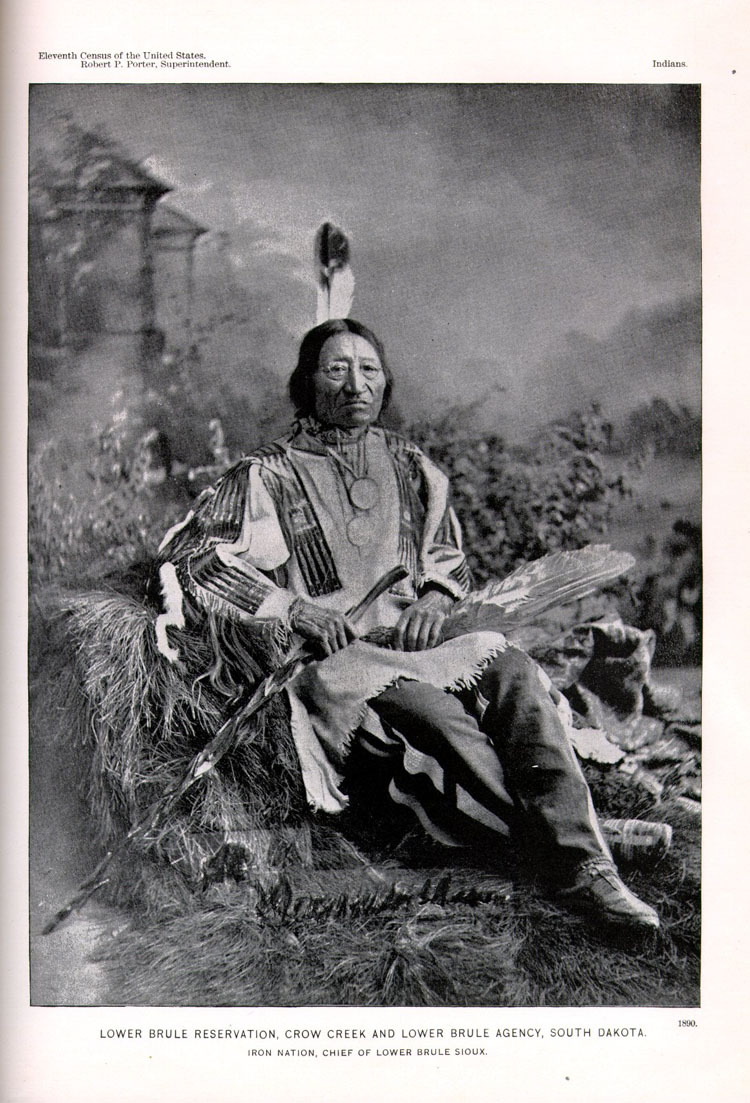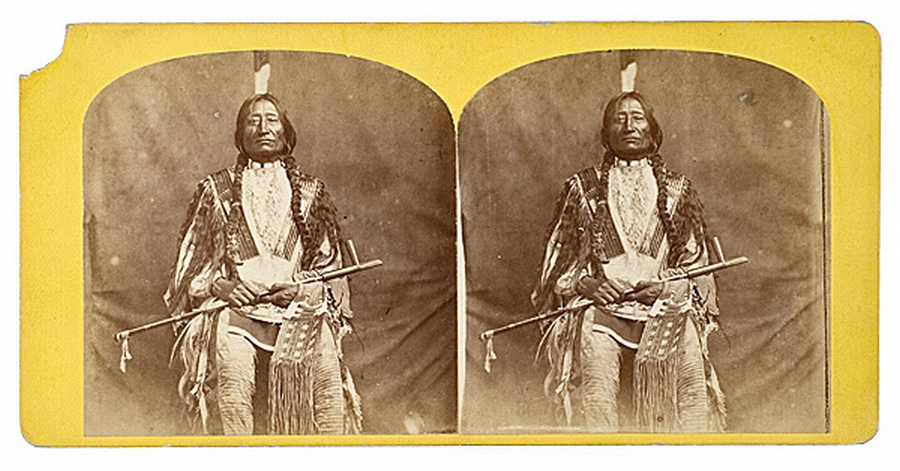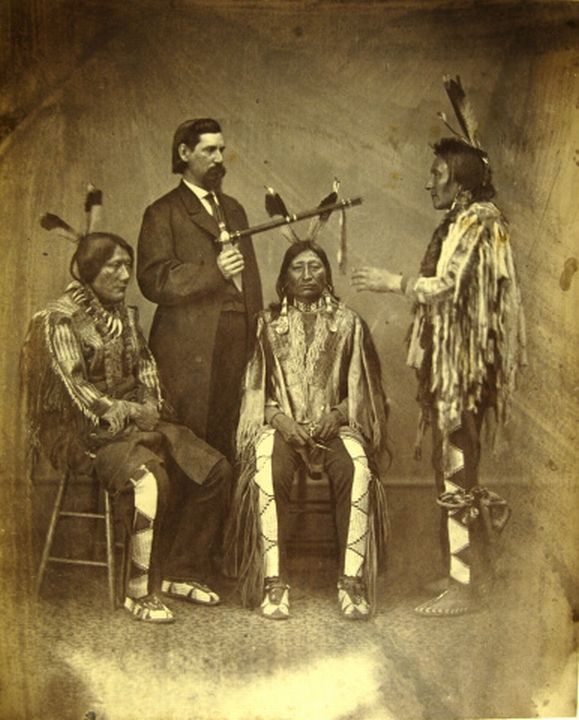|
|
Post by Dietmar on Jun 23, 2008 10:07:33 GMT -5
Maza Oyate aka Solomon Iron Nation was an outstanding chief and perhaps the most important leader of the Lower Brule tribe.  (by Antonio Z. Shindler 1867) Our great chief, Iron Nation, was popular because he wasn´t a warrior or a great medicine man or a Ghost Dancer. He was a chief and a peace maker. He got his people engage in peace and in farming and stock raising. The Iron Nation Tribe of Lower Brule was going to get 50 head of mares from the goverment and also 100 blankets but he gave this to other tribes to quiet their warriors so Iron Nation is a great peace maker...(news item submitted by Reuben Estes in Indians at Work, 5, Number 11 (July 1938) Here are some SIRIS photos of him:   (both photos by A. Z. Shindler 1867)  (by C.M. Bell 1880)
|
|
|
|
Post by Dietmar on Jun 24, 2008 9:48:47 GMT -5
There is not too much information about Iron Nation in the net or in books, but here is some more: Chief Solomon Iron Nation from Lower Brule, SD Inducted in 2006 Category: Indian Heritage DOB: February 1815 POB: Dakota Territory DOD: November 14, 1894 Buried at: Lower Brule, SD Historical accounts of Chief Solomon Iron Nation are scant. However, the available information depicts him as a chief living his life trying to ensure that the Lower Brule Tribe would survive and its members would lead a good life. His life covered seventy-nine of the most tumultuous and disastrous years that the Lower Brule people, and most other Native Americans, have ever endured. Iron Nation was born February, 1815, just nine years following completion of the Lewis and Clark expedition into a West unknown to America’s white society. His life spanned the Dakota Territory transformation from an isolated, unknown frontier to a growing territory and on to South Dakota’s 1889 statehood. By all historical accounts, Chief Iron Nation, referred to as “The Red Man’s Moses”, was a positive force during this transitional period for South Dakota. Chief Iron Nation is the most notable historical figure from the Lower Brule Tribe and is best known for his signing of the significant Dakota Territory treaties of the 1800’s, to include the 1851 Ft. Laramie Treaty, the 1865 Ft. Sully Treaty and the Ft. Laramie Treaty of 1868. Chief Iron Nation died as the tribe’s last Head Chief on November 14, 1894, in the Iron Nation District of the Lower Brule Reservation. The people of Lower Brule erected a nearly 7ft. tall granite monument over his grave. This was the first monument to be erected over the grave of a Lakota (Sioux) Chief in the history of South Dakota. www.sdhalloffame.com/bio.cfm?cat_id=15&inductee_id=602 |
|
|
|
Post by grahamew on Jun 24, 2008 13:00:24 GMT -5
Here's another one - about 1890, I think:  |
|
|
|
Post by miyelo on Jun 24, 2008 16:35:56 GMT -5
he was a ''hang around the fort'' to us ''wild indians'' who wanted nothing to do with the wasichu ways or goods. lol.
|
|
|
|
Post by Dietmar on Apr 3, 2011 14:56:22 GMT -5
This photograph has been labeled as Left Hand, Yankton, on an auction site (Cowan). I believe it has been mis-identified. In my opinion it is more likely that the the individial is Chief Iron Nation, Lower Brule:  Note the war-shirt with porcupine quills, which Iron Nation is wearing in most of his portraits. The Yankton Left Hand was photographed as a delegate in Washington in 1867. He is not the same man pictured here. |
|
|
|
Post by kingsleybray on Apr 4, 2011 9:21:15 GMT -5
Great picture, Dietmar.
Could this be a Charles T. Hamilton image? And, possibly from the OCtober 1865 treaty councils at Ft Sully, where we know Hamilton took many photographs. See Hamilton's thread in the Photographers section.
|
|
|
|
Post by Dietmar on Apr 7, 2011 14:00:38 GMT -5
Kingsley,
I have no proof for it, but I wouldn´t be surprised if it is a Hamilton.
|
|
|
|
Post by Dietmar on Apr 13, 2011 10:40:39 GMT -5
Here´s another portrait of Iron Nation, taken on his trip East in 1867:  Medicine Bull (Lower Brule), Charles F. Picotte (interpreter), Iron Nation (Lower Brule), Yellow Hawk (Sans Arc) |
|
|
|
Post by Dietmar on Mar 8, 2013 10:43:59 GMT -5
This is a portrait of Iron Nation that Grahame has found at an auction site:  |
|
|
|
Post by semeja on Dec 31, 2014 14:42:05 GMT -5
Iron Nation is my wife's great, great, great grandfather. Her father Steve Byrnes has got his grave site on the National Register of Historic Places.
|
|
|
|
Post by Dietmar on Jan 1, 2015 11:59:08 GMT -5
Welcome semeja,
I hope you like this thread about your wifes´ ancestor. I had been in contact with members of the Byrnes family earlier and have handed on some photos.
Greetings
Dietmar
|
|
|
|
Post by michaela on Apr 27, 2015 22:42:26 GMT -5
This is my grandfather. Thank you for this thread.
|
|
|
|
Post by kingsleybray on Jan 11, 2016 8:30:27 GMT -5
Although he became the most influential Lower Brule chief, Iron Nation was born, about 1815, into the Yankton Dakota tribe. He grew up in the Wakmuha-owin band, Pumpkin Rind Earrings, one of the bands of the Upper Yanktons. Its chief was White Medicine Cow That Stands (1828-1901). I don't know if the two men were related.
Hunting the east side of the Missouri valley around the White river confluence, the Upper Yankton bands were close neighbours to the Lower Brule Lakota, who ranged lower White river and the west side of the Missouri valley. Iron Nation met and married a Brule woman, presumably in the 1840s, and moved permanently to live with his wife's people. His wife came from the Walega-un-wohan (Boil in Bladder) tiyospaye of the Lower Brule, and he became the headman of that band. He is an important example of a Lakota leader who won leadership among his in-laws' tribal division.
I don't know anymore about Iron Nation's or his wife's parentage. From census information his wife Hail (Wasu) was born about 1830-31.
|
|
|
|
Post by kingsleybray on Jan 11, 2016 9:55:09 GMT -5
I just updated the above message.
|
|
|
|
Post by middlepath on May 23, 2017 18:13:59 GMT -5
Thank you for posting this. This is truly fascinating. According to my cousin at Lower Brule, Iron Nation was my great-great-grandfather. He married my great-great-grandmother, Hail (Wasu).
|
|